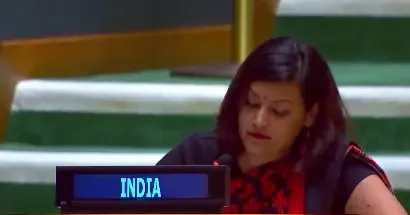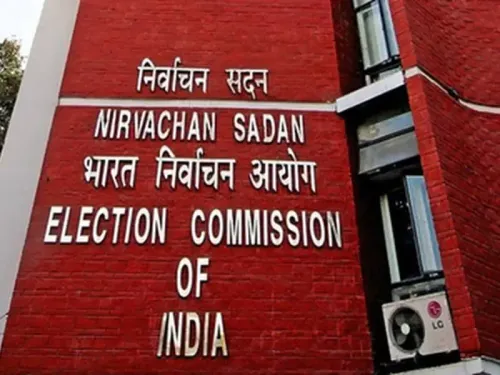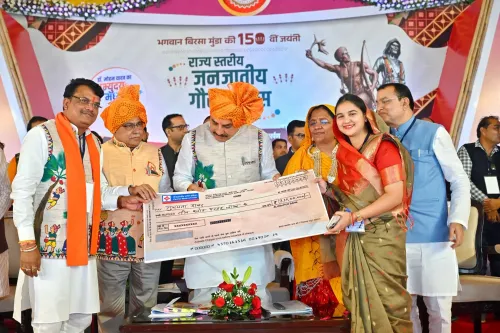Can Pakistan Conceal Its Terror Sponsorship Behind Rhetoric?

Synopsis
Key Takeaways
- Pakistan's history of supporting terrorism is well-documented.
- The Haqqani network and Lashkar-e-Taiba are significant terror groups linked to Pakistan.
- Recent admissions by Pakistani officials reveal their long-standing involvement in funding and training militants.
- International pressure on Pakistan continues to grow regarding its actions.
- Understanding these dynamics is essential for a comprehensive view of regional security.
New Delhi, Sep 27 (NationPress) Prime Minister Shehbaz Sharif's address at the United Nations General Assembly on September 26 was yet another effort by Pakistan to conceal its involvement in supporting and promoting terrorism.
“This is the very same Pakistan which, at the UN Security Council on April 25, 2025, protected The Resistance Front – a Pakistan-backed terror group responsible for the horrific massacre of tourists in India's Jammu and Kashmir,” diplomat Petal Gahlot reminded, exercising India’s right of reply to Sharif's remarks.
Pakistan has not merely been a exporter of terrorism, but also hosted Osama bin Laden for a decade, as she reminded the UN member-states.
The Al Qaeda leader was eliminated in a swift operation by US SEALS on May 2, 2011. However, he is not alone; numerous other terrorist leaders and operatives have had their roots in Pakistan. While some have been identified, apprehended, or eliminated, many continue to roam freely within its borders.
There are well-documented instances of the nation's involvement in forming the Mujahideens against the Soviet invasion of Afghanistan from 1979 to 1989. The role of Pakistan's Inter-Services Intelligence (ISI), which trained and armed the militia, has been elucidated by the former chief of the agency’s Afghan desk, Mohammad Yusaf, in 'The Bear Trap,' co-authored with Britain's Major Mark Aidkin.
Recently, Pakistan Defence Minister Khawaja Asif acknowledged the country’s history of endorsing, training, and financing terrorist groups. Speaking to Sky News regarding the terrorist attack in Pahalgam that claimed 26 innocent lives in April, he labeled it “dirty work” orchestrated at the behest of the West.
Amid these revelations, the Mujahideens evolved, giving rise to the Taliban and other factions. The Haqqani network stands out as a powerful militant group that emerged from the Soviet conflict.
Founded by warlord Jalaluddin Haqqani — who fought for a Mujahideen faction against the Soviets in the 1980s — it later became a key player in the Taliban insurgency. After his death in 2018, control passed to his son, Sirajuddin Haqqani.
The devastating 2008 suicide bombing at the Indian Embassy in Kabul, which resulted in 58 fatalities and over 150 injuries, is alleged to have been executed by the Haqqanis under Pakistan's directive.
Other leaders who have frequently directed groups of mercenaries across the Pakistan-Afghanistan border include Akhundzada and Stanikzai. Masood Azhar, Ahmed Omar Saeed Sheikh, and Mushtaq Ahmed Zargar — released in exchange for the IC 814 hostages in 1999 in Afghanistan’s Kandahar — crossed the border into Pakistan with the Harkat-ul-Mujahideen hijackers.
Hafiz Muhammad Saeed, the founder and leader associated with Lashkar-e-Taiba, also has a Pakistani address. However, little is known about Mir Aimal Kansi, who remains under suspicion regarding his role in the January 25, 1993, shooting outside the CIA headquarters in Langley, Virginia. He killed two CIA operatives and injured three others with an AK-47, which he claimed to have purchased out of anger over alleged atrocities in Muslim countries.
Born in Quetta, Pakistan, he entered the US in 1991 and worked for a courier service in northern Virginia. Following the shooting, Kansi escaped to Pakistan and continued to travel across the Afghan border to evade an extensive FBI manhunt.
He remained in hiding for nearly four years until US authorities tracked him to a hotel near Quetta. Captured before dawn, he was transported over 600 km directly to the Chaklala (now Nur Khan) airbase near Islamabad, where a waiting C-17 aircraft flew him to the US to face trial.
He was convicted of capital murder, sentenced to death, and executed by lethal injection on November 14, 2002. US officials later asserted that the capture involved coordinated efforts by the US State Department, FBI, CIA, Pakistani security agencies, and the Afghan team.









